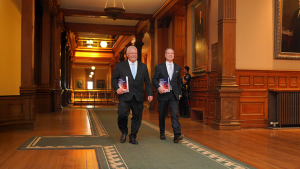The use of a company as a means of avoiding bearing business losses is neither unusual nor a basis for lifting the veil.
Court Refuses To Pierce Corporate Veil For Breach Of Contract
by Paul Sandori
Noel Developments Ltd. v. Metro-Can Construction (HS) Ltd.
Condominium developer entering construction contract with subsidiary, then attempting to make parent company responsible for breach of contract ? condo owners also attempting to make parent company responsible, for enforcement of warranty ? as developer had knowingly entered contract with subsidiary, for developer?s own purposes, parent company?s corporate veil could not be pierced ? ruling that veil could not be lifted to make parent party to construction contract barred owners? claim to enforce warranty in contract directly against parent ? since owners might be able to claim in tort against parent, parent?s motion to dismiss proceedings dismissed
The two actions summarized below and several other actions involve the construction of two residential towers on the waterfront of Vancouver called Harbourside Park. The project was undertaken by Noel Developments Ltd. and SPF Properties Inc. In the court decision, the judge called the two companies ?Noel? for short.
Noel entered into a construction contract with Metro-Can Construction (HS) Ltd. as prime contractor. Late in the construction process, Noel fired Metro-Can (HS) and took over the project. Metro-Can (HS) then sued Noel for breach of contract. Noel countersued Metro-Can (HS) and its parent company, Metro-Can Construction Ltd.
The condominium owners started a separate action against all three companies: Noel, Metro‑Can and Metro-Can (HS). Their action was for damages, to repair construction deficiencies such as leaking window‑walls. In that action, Noel took third party proceedings against Metro-Can and Metro-Can (HS) alleging that the claimed deficiencies were their fault.
In these three actions, numerous other parties were also joined: various other contractors and subcontractors, architects, engineers and sureties. As well, there were many other related actions by parties claiming that they have not yet been paid for their services and/or materials.
The following decision deals with a motion by Metro-Can which asked the court to dismiss the proceedings against it.
The first reason for Metro-Can?s motion was contractual. The claims of Noel and the owners against Metro-Can were based on the construction contract between Noel and Metro-Can (HS). Metro-Can took the position that Noel and the owners had no claim against Metro‑Can because it was not a party to that contract. Noel and the owners, however, argued that Metro-Can (HS) was no more than the ?alter-ego? of Metro-Can and that the parent company was the real contracting party.
Noel did not wish to contract with the parent Metro-Can because it had a certain union affiliation which Noel wished to avoid. The use of the subsidiary was also convenient to Metro-Can as it wished to protect the parent company from liability. It was common practice to have separate subsidiary companies incorporated for separate projects.
The purpose of Noel?s motion was, in effect, to ?pierce the corporate veil? of Metro-Can (HS) to make Metro-Can a contracting party because the parent company had financial substance, not the subsidiary.
There was evidence that, in practically every conceivable way, the subsidiary was run by the parent which owned 100 per cent of the shares of the subsidiary, and provided the initial financing required for the project. The personnel of the subsidiary were officers or employees of the parent.
Metro-Can contended, however, that Noel was well aware that it was contracting with the subsidiary and could not later take the position that the contract was really with the parent, without some evidence that Noel had been misled as to the company with which it was contracting. There was no evidence that this had occurred.
Noel argued, on the other hand, that case law supported the proposition that no such misconduct is needed. Alternatively, Noel maintained that Metro-Can was guilty of misconduct. For example, it alleged that Metro-Can was part of a conspiracy to extort extra money under the construction contract and that it deliberately caused breaches of the contract in order to gain certain advantages. These issues, said Noel, required detailed exploration at trial and could not be fairly resolved on a summary motion.
Metro-Can denied the alleged misconduct. Moreover, it argued that, in any case, the allegations related to the carrying out of the contract and could not make Metro-Can a party to the contract.
Noel cited a number of cases in support of its position but did not persuade Mr. Justice Shaw: ?? no case has been cited which would justify lifting the veil in the circumstances of the present case,? said the judge. In his opinion, the applicable law was settled in the decision of the B.C. Court of Appeal in B.G. Preeco 1 (Pacific Coast) Ltd. v. Bon Street Holdings Ltd.
In that case, the plaintiff tried to make the principals of a company liable on a contract the company had entered into. The Court of Appeal refused to lift the corporate veil to make the principals liable on the contract even though it held them liable in fraud. The court considered fraud or improper conduct as a basis for lifting the corporate veil, but confined it to situations where ?a corporation is used to effect a purpose or commit an act which the shareholder could not effect or commit.?
The fraud that the principals had committed was to make the plaintiff believe that the company had assets that it, in fact, did not have. The court in Preeco decided that that had nothing to do with the corporate veil. The use of a company as a means of avoiding bearing business losses is neither unusual nor a basis for lifting the veil.
Thus, even assuming that Noel?s allegations of wrongdoing by Metro-Can could be proven, Noel, at best, might have a separate action ? such as fraud ? against Metro‑Can but it could not make out a claim for breach of contract.
In arguing the alter-ego issue, Noel relied on the management agreement between Metro‑Can and Metro-Can (HS). Justice Shaw commented:
I see no difference in substance between it and an agreement, express or implied, between the principal of a ?one man? company and the company itself pursuant to which the man runs the company. He may be the company?s sole shareholder, sole officer, sole employee, its sole source of financing and indeed, the very reason for that company having anything to offer anyone doing business with the company, but when someone knowingly enters into a contract with that company, the corporate protection afforded to the principal against personal liability must apply. The policy of limited liability is the very essence of the legislation that provides for the incorporation of limited liability companies.
The Preeco case, concluded the judge, closed the door to the parent company being made a party to the subsidiary?s contract on the facts of this case.
As another approach, Noel argued that Metro-Can and Metro-Can (HS) were involved in a joint venture and so Metro-Can was equally liable with Metro-Can (HS) for any contracts entered into by Metro-Can (HS). The court found no joint venture. There was no joint interest in the construction contract, no mutual control between the two companies. Metro-Can (HS) did not have a right to participate in the profits because, according to the evidence, the profits were paid to Metro‑Can as remuneration for its management services.
Was there perhaps a partnership between Metro-Can and Metro-Can (HS)? If that were the case, Noel contended that this would give rise to joint liability of the two companies. A partnership is defined in the British Columbia Partnership Act as the relation ?between persons carrying on business in common with a view of profit.? There was no partnership, decided Justice Shaw, since all of the profit was to be received by only one of the companies.
Noel?s claim against Metro-Can for damages for breach of the construction contract was dismissed, based on the finding that Metro-Can was not a party to the construction contract.
There remained the claim of the condominium owners. Their most significant allegation was that the window-walls of the residential towers leaked and caused toxic mould to form which posed a danger to the occupants. The cost of repair or replacement could run as high as $12.5 million. There were other defects which needed to be repaired at a cost of approximately $1.3 million.
The owners contended that the dangerous state of their premises was caused by the fault of various parties, including the architects, the engineers, the developers, the contractors, the subcontractors and the suppliers ? in short, just about anyone who had anything to do with the construction of the towers. The owners? claims against Metro-Can and Metro-Can (HS) were solely for economic damages, namely, loss of money.
The owners placed particular reliance on the decision of the Supreme Court of Canada in Winnipeg Condominium Corp. No. 36 v. Bird Construction. In that case, Mr. Justice La Forest said:
I conclude that the law in Canada has now progressed to the point where it can be said that contractors (as well as subcontractors, architects, and engineers) who take part in the design and construction of a building will owe a duty in tort [of negligence] to subsequent purchasers of the building if it can be shown that it was foreseeable that a failure to take reasonable care in constructing the building would create defects that pose a substantial danger to the health and safety of the occupants. Where negligence is established and such defects manifest themselves before any damage to persons or property occurs, they should, in my view, be liable for the reasonable cost of repairing the defects and putting the building back into a non‑dangerous state.
Metro-Can and Metro-Can (HS) pointed out that no repairs had yet been carried out and submitted that the case law did not go so far as to allow claims for pure economic loss when the expense claimed for the repairs has not yet been incurred. In reply, the owners contended that no precedent case went so far as to decide that the cost of necessary repairs could not be recovered until that cost has actually been incurred. They also said that they had to press the lawsuit in order to get the money to make the repairs.
Quite apart from the tort of negligence, the owners also relied upon various contractual warranty provisions whereby the contractor warranted to the developer and the Condominium Corporation that, among other things, ?all work shall conform to the requirements of the contract documents and shall be performed in a safe and careful manner??.
The owners asked the court to find liability against Metro-Can and Metro‑Can (HS) on the warranty provisions even though the owners were not a party to the construction contract. They cited a line of cases that deal with exceptions to the privity of contract doctrine.
In addition, the owners argued that, in any case, the law of negligence is still developing and the facts of the case were simply not sufficiently clear, and likely will not be until trial, to warrant making a decision on the contested points of law.
Having ruled earlier that the corporate veil of Metro-Can (HS) could not be lifted in order to make Metro-Can a party to the construction contract, the judge found that this ruling barred the owners? claim to enforce the warranty of the construction contract directly against Metro‑Can. This, however, did not preclude their making a claim in tort against Metro-Can pursuant to the Winnipeg Condominium case.
He could therefore not wholly dismiss the owners? claims against either Metro-Can or Metro-Can (HS). The points raised in the motion were left open to be eventually raised at the trial.
Supreme Court of British Columbia
Shaw J.
December 12, 1999










Recent Comments
comments for this post are closed